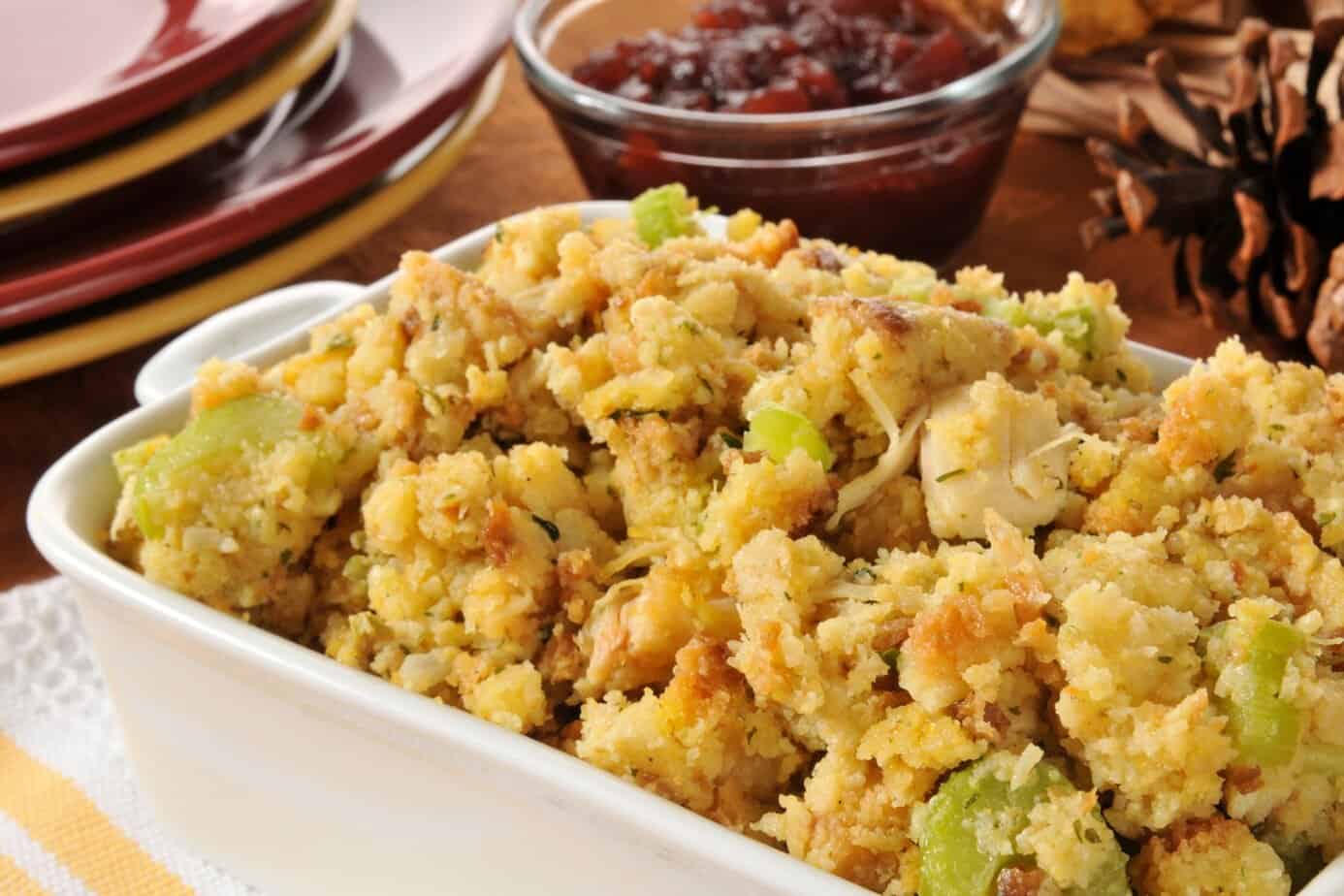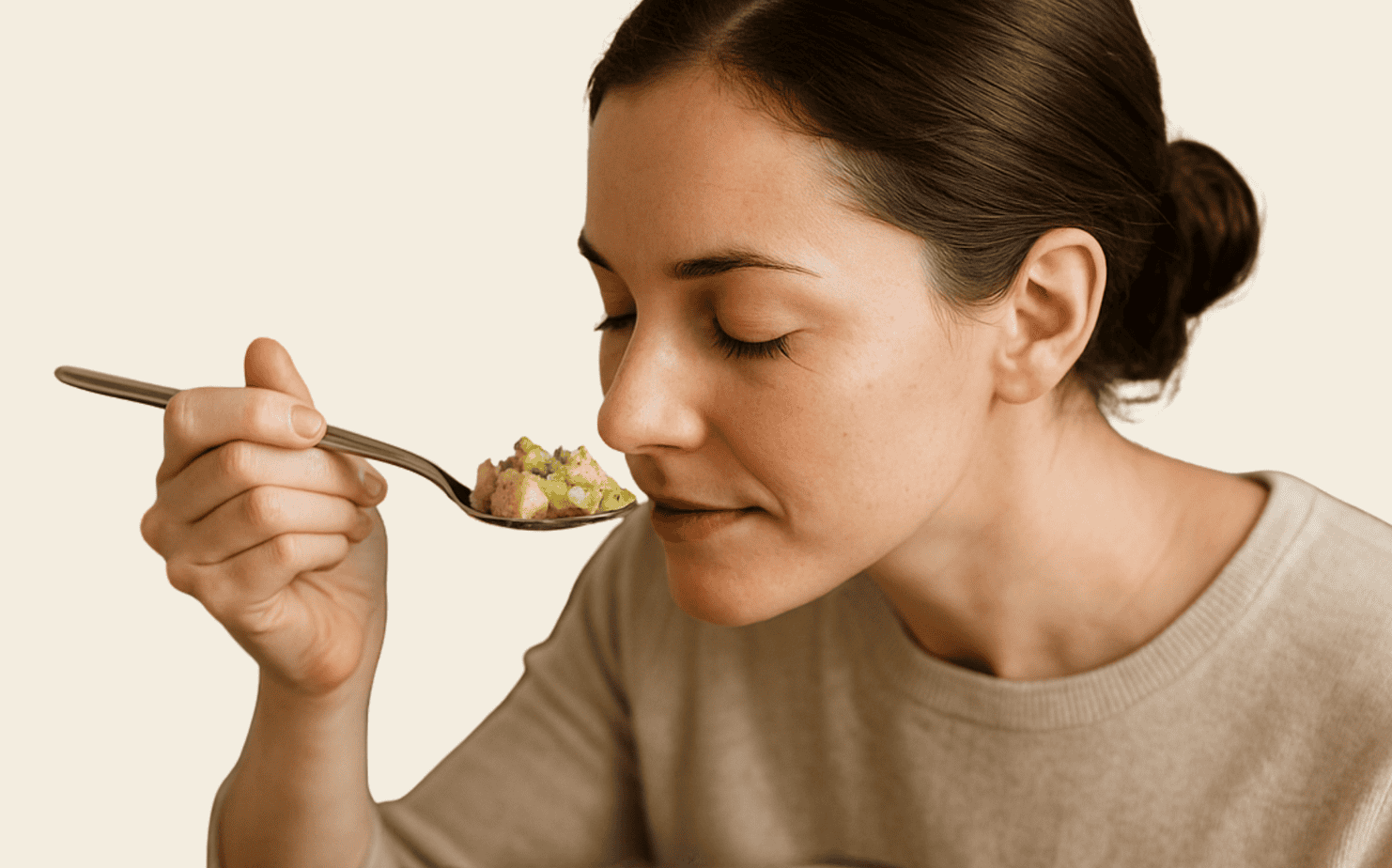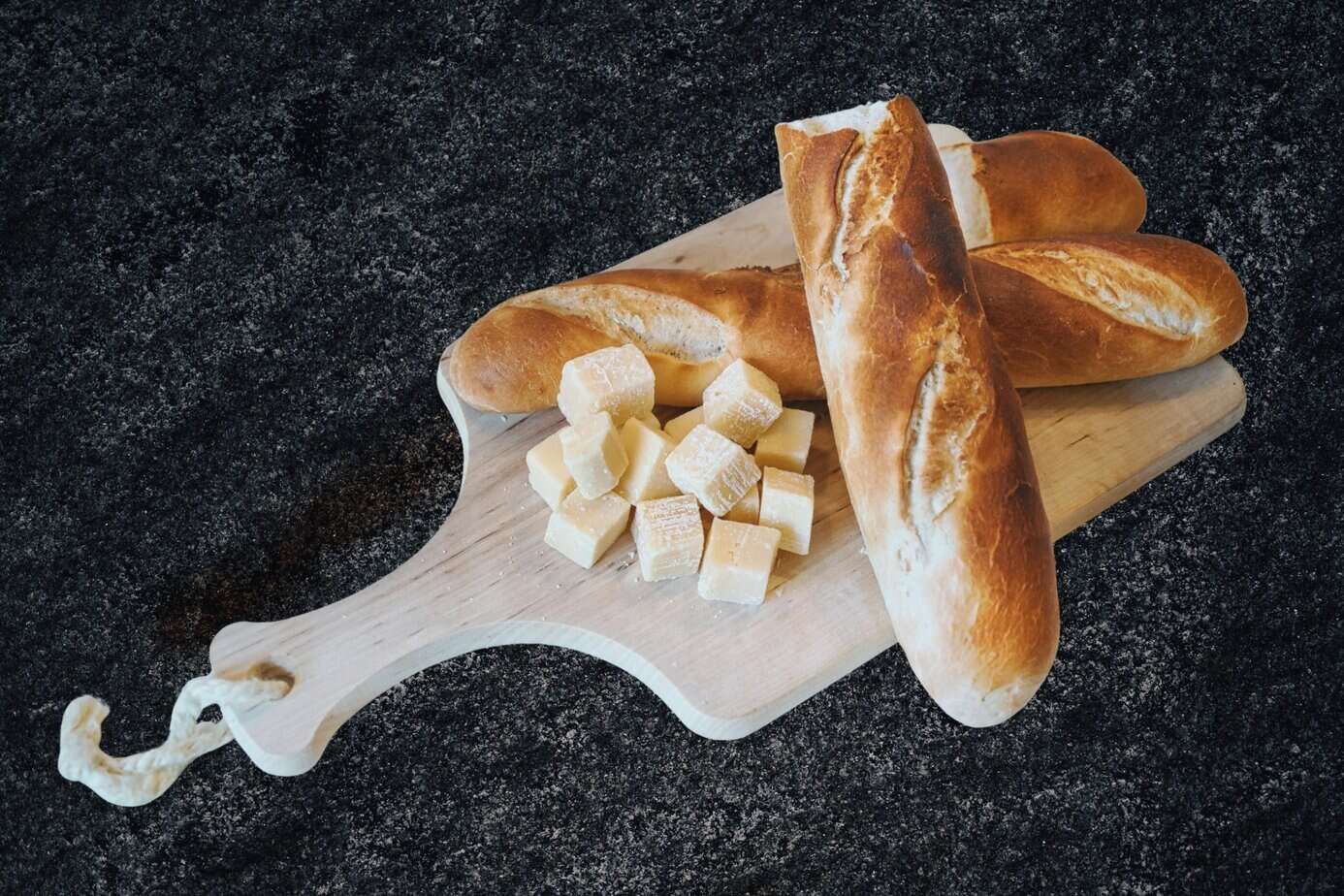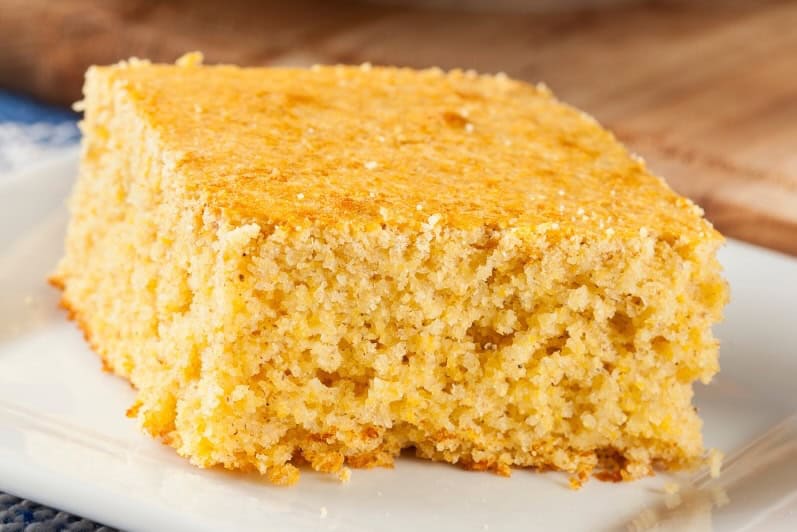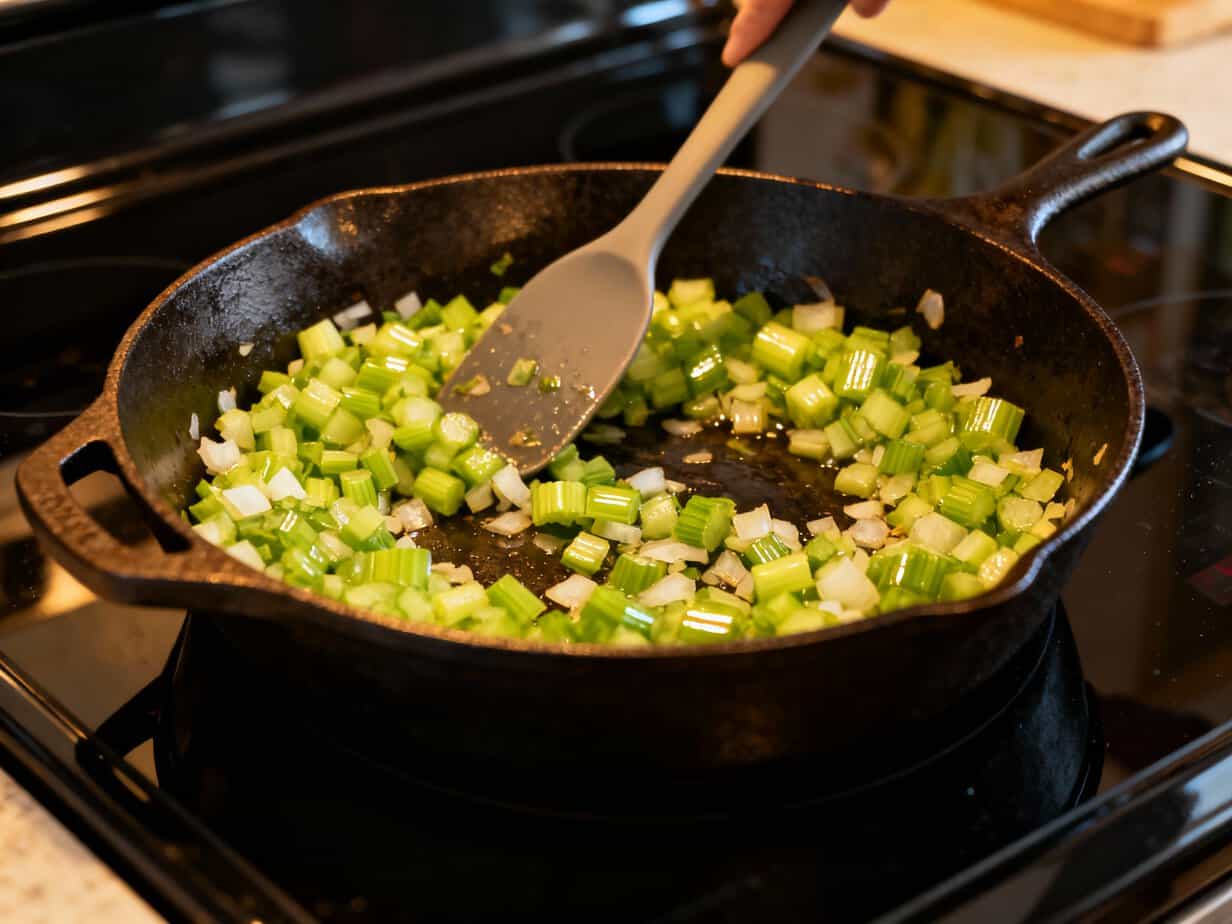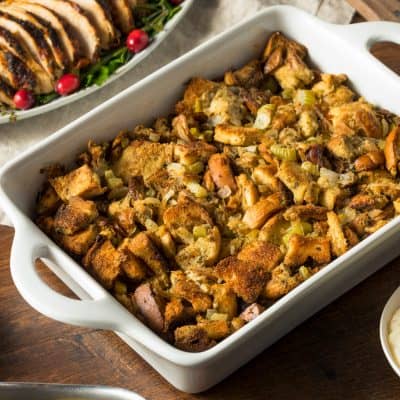This gluten-free stuffing is packed with holiday flavor—tender bread cubes, aromatic herbs, and golden sautéed vegetables that smell like Thanksgiving should smell. Whether you use gluten-free bread or gluten-free cornbread, the result is moist, savory, and so perfectly seasoned that your gluten-eating relatives will be sneaking seconds without realizing it’s “special diet” food.
The secret? My mom’s foolproof sage test. If you can’t immediately smell the sage when you lean over the bowl, add more. That’s it. That’s the trick that turns good stuffing into “can I get the recipe?” stuffing.
From Cardboard to Culinary Victory: My Gluten-Free Stuffing Journey
For years after I quit eating gluten, I avoided stuffing entirely. Back then, gluten-free bread tasted more like cardboard than bread—flavorless, dense and hard, or crumbling into dust at the slightest touch. I gave up on bread completely, not just gluten. Every Thanksgiving, I watched everyone else pile their plates high with that golden, herb-scented perfection while I ate extra potatoes and told myself it was fine.
It wasn’t fine. Stuffing was my favorite part of the meal—the one dish I looked forward to all year.
Fast forward several years. Gluten-free bread had improved dramatically. In fact, at our Spice Cure booth, I regularly get compliments on the bread I use for sampling from people who have no idea it’s gluten-free—including culinary students! My mom always made her own dried bread for stuffing, so one year I decided to try her method with my gluten-free bread.
Bingo! The results were so incredible that we no longer make a separate small bowl of gluten-free stuffing. My mom was amazed. Now everyone gets the gluten-free version, and nobody knows the difference.
I’d never tried cornbread stuffing before, but one time when I had leftover cornbread made with Bob’s Red Mill Gluten-Free Cornbread Mix, I decided to dry it and give it a shot. It was fabulous—sweeter than Mom’s classic version but absolutely delicious. Now I regularly dry leftover cornbread to use for stuffing or as breadcrumbs in other recipes, enjoying both the taste and peace of mind.
Mission accomplished.
Why This Gluten-Free Stuffing Works
Gluten-free stuffing no longer has to compromise on flavor or texture. Here’s how each step and ingredient combination creates a stuffing everyone will love—whether you’re cooking for gluten-free guests, cornbread fans, or classic bread lovers.
The Drying Step Is Non-Negotiable
Properly dried bread cubes are the foundation of great stuffing. Skip this step and you’ll get soggy, mushy disappointment. Dry cubes absorb the herb-infused butter and broth perfectly, creating that ideal tender-but-not-wet texture.
Bread vs. Cornbread: Both Win
Classic gluten-free bread gives you traditional stuffing vibes—familiar, comforting, what Grandma made. Cornbread adds a subtle sweetness and Southern charm that pairs beautifully with sage and onion. Can’t decide? Make both and let guests choose.
Ghee, Duck Fat, or Olive Oil
Ghee (clarified butter) is my top choice—it’s mostly casein-free, has incredible flavor, and creates that golden, crispy exterior. Duck fat is next-level delicious if you can find it. Olive oil keeps it completely dairy-free and works beautifully for vegan guests.
New to ghee? Check out my blog post How to Make Ghee at Home: Benefits & Butter Comparison.
The Sage Test
This is the wisdom my mom passed down: smell the stuffing before baking it. If sage doesn’t hit you immediately, add more. Sage is the star of stuffing, and without enough, it tastes flat. Trust your nose.
Stuff the Bird, Bake the Rest
Stuffing cooked inside the turkey absorbs those incredible drippings and becomes transcendently flavorful. But it never all fits in there, and the crispy edges on the baked version are equally beloved. Win-win.
Health Benefits of This Stuffing
Let’s be clear: stuffing is a high-carb, comfort-food side dish, and I’m not going to pretend it’s a superfood. Bread—even gluten-free bread—isn’t a nutritional rockstar. However, compared to packaged mixes full of preservatives, artificial flavors, excess sodium, and seed oils, this homemade version uses real ingredients that your body actually recognizes.
- And if you’re looking for a lower-carb, more nutrient-dense option, consider a Wild Rice Stuffing with Sausage like this one with only 7.9 net carbs per serving and 14 grams of protein
Here’s what this classic stuffing does have going for it:
Celery: The Unsung Hero
Six cups may sound like a lot, but it’s what keeps this stuffing moist and flavorful. Celery is rich in antioxidants, anti-inflammatory compounds, and gut-supporting fiber. Plus, it adds that essential aromatic foundation that makes stuffing smell like the holidays.
Onions for Immune Support
Onions contain quercetin, a powerful antioxidant that supports immune function and reduces inflammation. They also add sweetness and depth that balances the savory herbs.
Sage: More Than Flavor
Sage has been used medicinally for centuries to support digestion, reduce inflammation, and even improve cognitive function. Plus, it’s what makes stuffing smell like Thanksgiving.
Ghee or Olive Oil: Anti-Inflammatory Fats
Ghee provides gut-supportive butyrate and fat-soluble vitamins A, D, E, and K, while olive oil brings heart-healthy polyphenols. Use whichever fits your dietary needs.
Real Ingredients, Real Nourishment
No MSG. No artificial flavors. No questionable additives. Just whole foods you can pronounce.
If you want the cleanest version possible, use a high-quality gluten-free bread or gluten-free cornbread made from simple, recognizable ingredients.
Choosing the Best Gluten-Free Bread for Stuffing
You can use any gluten-free bread you enjoy that your dietary needs. Perhaps you’re fortunate enough to live near a gluten-free bakery that uses clean ingredients. Most gluten-free breads contain gums and preservatives, which is normal for gluten-free baking. If you’re looking for cleaner ingredient lists and can find these where you live, below are brands I trust:
- Simple Kneads (cleanest, allergy-friendly)
Ingredients: Water, millet flour*, sorghum flour*, teff flour*, quinoa flour*, buckwheat flour*, psyllium husk*, flax seed meal*, raisin juice concentrate*, sunflower seeds*, olive oil*, citrus fiber*, sea salt. (*organic).
You can find it on Amazon.
- Franz Gluten-Free Sourdough (cleaner than many gluten-free breads and egg-free)
Ingredients: Water, brown rice flour, tapioca starch, tapioca syrup, high oleic safflower oil, potato starch, corn starch, xanthan gum, and 2% or less of: sunflower lecithin, salt, cultured rice flour, yeast, enzymes. Find it at some grocery stores, at Franz Bakery Outlets, or on Amazon.
- Bob’s Red Mill Gluten-Free Cornbread Mix (whole grains, non-GMO)
Ingredients: Whole grain cornmeal, potato starch, whole grain sorghum flour, cane sugar, whole grain corn flour, tapioca flour, baking powder (sodium acid pyrophosphate, baking soda, cornstarch, monocalcium phosphate), sea salt, xanthan gum. Find it on Amazon.
If you have time and want the cleanest option, you can also make your own gluten-free bread or cornbread from scratch. However, just getting Thanksgiving dinner on the table is a big enough lift on its own, so using one of these cleaner convenience options is absolutely fine.
Quick How-To: Gluten-Free Stuffing
Most of the time for making stuffing is hands-off time for bread drying and baking (about 45 minutes in a casserole or time in the turkey). Prep time is only about 15 minutes. Here are the easy steps:
- Dry bread or cornbread cubes until crisp (oven, dehydrator, or overnight).
- Sauté celery and onion in ghee until soft and golden.
- Toss the bread cubes with herbs and seasonings.
- Pour the warm vegetable mixture over bread and mix.
- Add broth gradually until moist but not soggy.
- Do the smell test—if you don’t smell sage immediately, add more.
- Stuff the turkey cavity loosely; bake the rest in casserole dish.
Frequently Asked Questions
Do I have to stuff the turkey?
Nope! You can bake all of it in a casserole dish. The stuffing inside the turkey gets amazing flavor from the drippings, but the baked version with crispy edges is equally beloved.
Can I make this in advance?
Yes—with a few safety precautions.
- Bread cubes: You can dry the bread cubes and store them in an airtight container at room temperature for up to a week. If they’re fully dried and sealed well, they’ll keep for several weeks. For longer storage, refrigerate or freeze.
- Stuffing mixture: You can sauté the vegetables and mix the stuffing ingredients together the day before. Transfer the mixture to a casserole dish, cover, and refrigerate. When baking chilled stuffing, add extra minutes and ensure the center reaches 165°F.
- Important: Don’t stuff the turkey ahead of time. Keep the stuffing in the refrigerator and loosely stuff the turkey right before roasting. If you’re baking it separately in a casserole, you can make it earlier in the day or the day before. Cool, cover, and refrigerate. Before reheating, drizzle a little broth over the top, cover with foil, and bake until hot. Uncover for the last 10 to 15 minutes if you want a crisp top.
My stuffing is too dry. Help!
Add more chicken broth, 1/4 cup at a time, and stir gently. It should look like well-moistened bread, not soup, but not dry either.
My stuffing is too wet!
This usually means the bread wasn’t dried enough before starting. Toast it in a 300°F oven for 10 to15 minutes to dry it out, then proceed.
Can I make this vegan?
Yes! Use olive oil instead of ghee and vegetable broth instead of chicken broth. It’s just as delicious.
Can I freeze the leftovers?
Absolutely! Cool completely, portion into airtight containers, and freeze for up to 3 months. When ready to eat, thaw overnight in the fridge if desired, then reheat in a 350°F oven until hot. For best results, drizzle a little broth on top, cover with foil, and uncover for the last 10 to 15 minutes for a crisp top—just like with make-ahead stuffing.
Get in the Kitchen!
This is the gluten-free stuffing that helps everyone enjoy Thanksgiving—no compromises and no “good for gluten-free” excuses, just genuinely delicious stuffing made for all. If you’re cooking for someone with celiac disease, a dedicated gluten-free kitchen is best, but most gluten-free guests will appreciate your effort and care in minimizing cross-contamination.
Make a batch in a casserole this weekend for practice. Get the drying and sage-testing down. Then on Thanksgiving, confidently serve stuffing that makes everyone go back for seconds.
Don’t forget to check out my complete AIRD Thanksgiving Menu for more allergy-friendly recipes that’ll make your holiday table inclusive and delicious!
Gluten-Free Classic or Cornbread Stuffing
Ingredients
- 16 cups dry gluten-free bread or cornbread cubes
- 1 cup ghee, duck fat, or olive oil
- 6 cups finely chopped celery, (about 10 to 12 ribs from 2 to 3 stalks/bunches)
- 3/4 cup chopped onion
- 4-6 teaspoons rubbed sage, or more to taste
- 2 teaspoons poultry seasoning, (See substitution in Notes)
- 1 teaspoon sea salt
- 1 teaspoon ground black pepper
- 1/2-1 cup chicken broth, (added gradually as needed for moisture)
Instructions
Prepare the Bread Cubes (Gluten-Free Bread or Cornbread)
- Use a quality gluten-free bread (dairy-free, egg-free, and nut-free if needed). Cut the bread into 1/2-inch cubes and dry them thoroughly in either a dehydrator (2 to 3 hours at 135 to 150°F, stirring halfway) or a low oven (about 250°F for 40 to 55 minutes, stirring every 15 minutes), until the cubes feel dry and crisp on the outside.
- For gluten-free cornbread stuffing, make two 8x8-inch pans (two packages of Bob’s Red Mill Gluten-Free Cornbread Mix) as directed. Once cooled, cut the cornbread into ½-inch cubes and dry as above. One package isn’t quite enough for 12 servings, but two will yield plenty—even some extra for other dishes.
Make the Stuffing
- Grease a casserole dish and set it aside.
- In a large skillet over medium heat, warm the ghee, duck fat, or olive oil until hot but not smoking. Add the celery and onion and cook, stirring occasionally, until they’re translucent and starting to soften, about 5 minutes.
- In a large mixing bowl, combine the bread cubes, sage, poultry seasoning, salt, and pepper. Pour the warm celery and onion mixture over the bread and toss to combine.
- Drizzle in the chicken broth a little at a time, gently stirring, until the bread looks uniformly moist but not soggy—like well-dampened bread rather than soup. Now use the test my mom taught me: smell the stuffing. If you don’t immediately smell sage, sprinkle in a bit more and stir again. Repeat as needed until the aroma comes through.
Stuff the Turkey
- Loosely spoon as much stuffing as will comfortably fit into the turkey cavity without packing it in. When baking inside the turkey, ensure the center of the stuffing reaches 165°F to guarantee food safety.
- Transfer the remaining stuffing to the prepared casserole dish, cover, and refrigerate until you’re ready to bake it. Bake the extra stuffing, covered, at 350°F for 30 to 40 minutes or until heated through. Uncover for the last 10 to 15 minutes to crisp the top.

